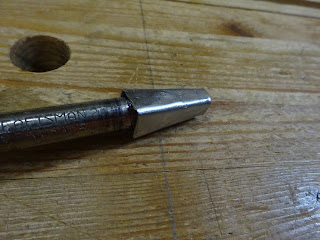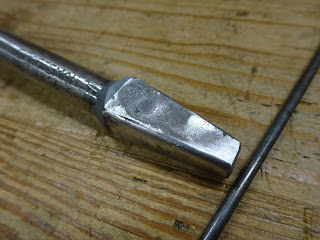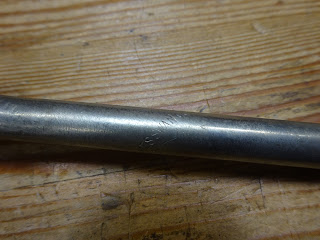In early August I posted about finding some tools at a garage sale. These tools were incredibly dirty and grungy. Finally I've had a chance to clean them up. The first up was a small pair of Stanley 84-120 needle nose pliers (made in Japan). All they needed was some Simple Green, a brass brush and a little sanding. These cleaned up beautifully and are already proving quite useful.
 |
| As found |
 |
| Cleaned up |
Next was a C. E. Jennings & Co. #10 auger bit, 11/16" diameter. I used the rust remover that I posted about a few weeks ago and it came out great. A wire wheel in a drill cleaned it up nicely. It's now sharp and the spurs and cutting lips are in good shape. And a bonus - this was one of the sizes missing from a set of bits I found at another sale recently.
 |
| As found |
 |
| Cleaned up and sharpened |
Next was the Stanley #51 spokeshave. This needed a little more work. After de-rusting the parts, I flattened the sole. A wire wheel in a drill helped to make the other parts shiny and presentable.
 |
| As found |
 |
| The sole was far from flat before this |
 |
| Cleaned up |
I've not used a #51 before, but I found the adjustment of the iron to be less of a problem than I thought it might be. I advance it with a hammer, and if I need to retract the iron, I've got to loosen the lever cap and pull it back manually. But it seems to hold it's position fine. I had thought it might shift left or right in use. I'll judge later how it performs in the long run.
Next up is the Stanley #5, WWII era. I think this is a type 17 because it has the hard rubber depth adjuster knob and black (or very dark) painted/lacquered hardwood (not rosewood) tote and front knob. It was disgustingly dirty, but cleaned up pretty easily with Simple Green and a toothbrush and brass wire brush. The iron and some screws needed some de-rusting as well.
 |
Stanley #5, type 17 from WWII era.
It's got the hard rubber depth adjuster and an inappropriate tote toe screw. |
 |
| The iron says "VICTORY" and "MADE IN USA |
 |
| Filthy, disgusting! (said with a French accent, from some childhood cartoon) |
 |
| Starting to flatten the sole - this needed a lot of work |
 |
Good enough |
 |
| The VICTORY iron de-rusted and cleaned up |
I scraped off the old paint/finish from the tote and knob, then added some "Dark Walnut" stain and about 5 coats of shellac, sanding between coats. Then I removed the sheen with some 0000 steel wool and waxed them. They look and feel great.
In the picture above, I had borrowed a tote toe screw from another plane. But since then I made one from a 1/4-20 bolt. I'll post about that separately.
It took a few tries to set the frog properly for a thin shaving, but once I got it, the shavings felt great. I think this has potential to be a great user plane.
Finally, there's the Starrett combination square with all three heads. This was also incredibly dirty and needed a fair bit of work to clean up.
 |
Starrett combo square with all three heads - what a find!!
|
 |
First up was cleaning with Simple Green
|
The blade and blade-locking hardware were then soaked in rust remover and then cleaned with a wire wheel. The protractor head had its scale wire-wheeled and the flat surfaces were rubbed briefly on sharpening stones and lightly sanded. On all three heads, I used a tip from Alfred, who commented on my earlier post about these garage sale tools. He said to make sure to clean out the slot for the rule, especially the grooves on each side of the raised ribs on which the rule sits. I used some cardboard, sliding back and forth until all was clean.
 |
| Here's the protractor head looking a lot better |
 |
| All parts cleaned up |
 |
| The blade looking much better |
Unfortunately, there are three issues with this set. First, the blade locks firmly into place in the centering head, but it will not lock into the protractor head or combination head. It seems the small crimp on the clamp screw is slightly off of where it should be. I've got to look into this some more to figure out what to do about it. It's possible that the clamp screws were made for a blade of greater width.
 |
Here's one of those clamp screws. The little crimped nub is
on the left side near the middle. It keeps the screw from going
too far down its hole and from rotating in the hole. |
Second, the protractor head has a tiny screw that locks the rotation at the angle you want. This screw has had half of it's head broken off.
 |
| That little screw goes in the hole I'm pointing to and the screw head locks the round part |
 |
| Here's a close-up shot of that screw missing half its head |
The thread is something like a #3-56 or something near that size. It's tough to count the threads on something that small. I'll take it to my local hardware store and see if they have a thread gauge that small.
And third, the scribe could not be held in place in the 90 / 45 degree head. I think the grime is the only thing that held it in place all those years. After I cleaned it up, the scribe was free to fall right out. But thanks to a Bob Rozaieski video that addressed this exact problem, I was able to fix it.
 |
| Back end of the 45/90 head. See the brass bushing in the scriber hole? |
 |
| I got it out with a bent paper clip and pliers |
 |
Those fingers on the brass bushing should be bent inwards to provide
a tight grip on the scribe |
This was a great fix. So glad to have found that video.
All-in-all, great finds at a garage sale for little money. I'm very happy about how easily they cleaned up. And they all should become user tools.










































